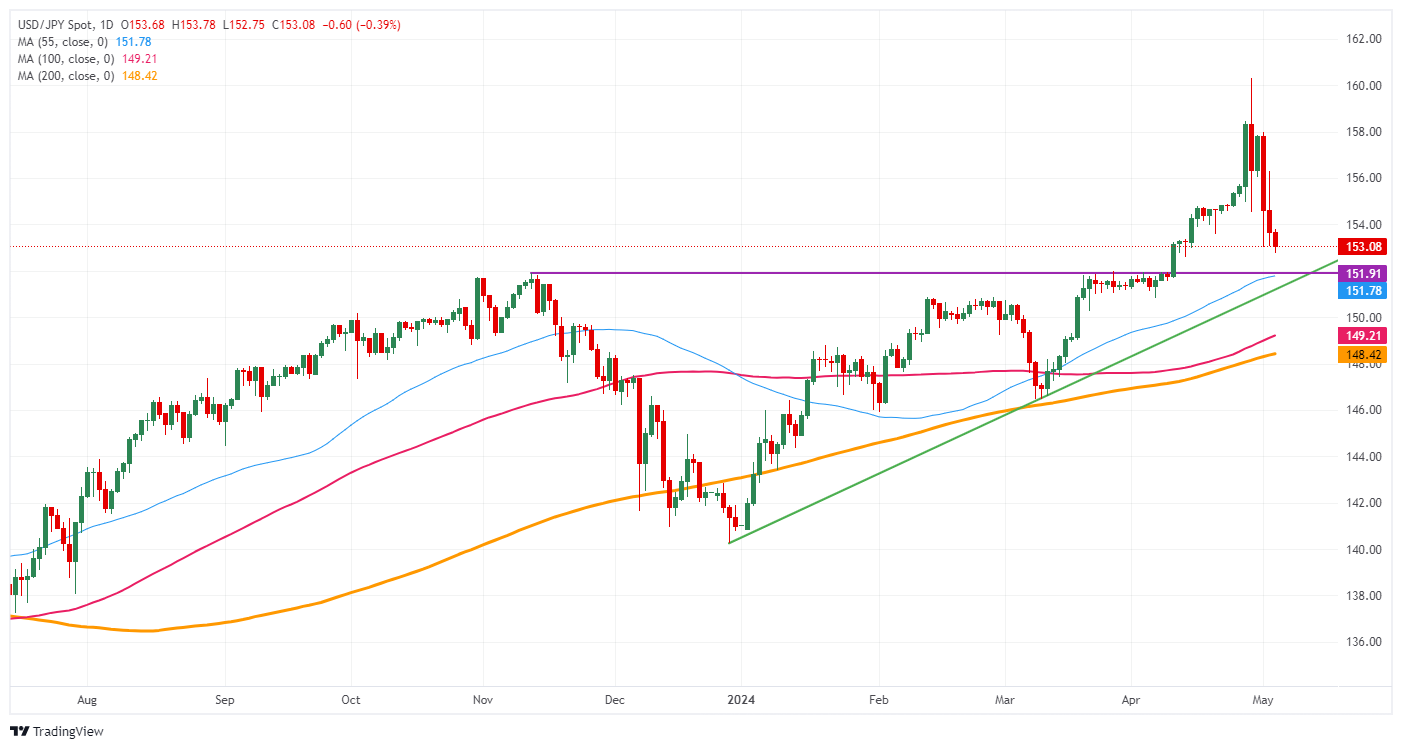USD/JPY could receive final nudge in its decline with NFP as catalyst

- The Japanese Yen is set to lock in a staggering performance for this week against the US Dollar.
- The Yen has appreciated over 3% following Japan’s intervention to propel the currency and the Fed’s less-hawkish rhetoric.
- The US Dollar Index holds ground above 105.00 but downside pressure builds up.
The Japanese Yen (JPY) is set to book one of its best weeks in history against the US Dollar. Since last Friday, a string of (un)confirmed interventions have pushed the USD/JPY pair from roughly 160.00 to 153.00. As the dust settles, the question is for how long the effect from these interventions will linger, and if they can keep USD/JPY trading at current levels or lower.
Meanwhile, the DXY US Dollar Index – which gauges the value of the US Dollar (USD) against a basket of six foreign currencies – is holding up around 105.00 as markets are stepping away in order not to get steamrolled by the Japanese interventions. Still, the recent depreciation of the Greenback could offer a window of opportunity for US Dollar buyers to step in and gear up for a profitable ride higher. This upturn could already happen on Friday with the US Jobs Report data for April on the docket. More broadly, the significant rate differential between the US and Japan isn’t likely to allow this big appreciation of the JPY against the USD to last long.
Daily digest market movers: Jobs report around the corner
- At 12:30 GMT, the US Employment Report for April is set to be released:
- US Nonfarm Payrolls changes are expected to increase by 243,000, lower than the 303,000 rise seen in March.
- Monthly Average Hourly Earnings are expected to grow at a stable 0.3%.
- The Unemployment Rate is set to remain at 3.8%.
- Several Japanese companies have reported to Bloomberg that they are facing substantial issues due to the recent weakness in the Japanese Yen. A boom in tourism is also putting pressure on local inflation.
- Japanese markets are closed on Friday for the Greenery Day bank holiday.
- Equities are trading in the green with both European indexes and US Futures up near 0.5% on average.
- The CME Fedwatch Tool suggests an 85.5% probability that June will still see no change to the Federal Reserve’s fed fund rate. Odds of a rate cut in July are also broadly out of the cards, while for September the tool shows a 60% chance that rates will be lower than current levels.
- The benchmark 10-year US Treasury Note trades around 4.57%, the lowest level this week, while Japanese 10-year JGB are trading at the high for this week near 0.889%.
USD/JPY Technical Analysis: It could get ugly at 152.00
The USD/JPY pair has still some room to fall, though a very lucrative entry level for Dollar bulls is just around the corner. Around 152.00, not only a pivotal level and the 55-day Simple Moving Average (SMA) is nearby, but also there is a long-term ascending trend line just beneath to provide support. This makes it the perfect entry level for any US Dollar buyers who foresee USD/JPY heading back to 160.00.
USD/JPY (daily chart)
Nonfarm Payrolls FAQs
Nonfarm Payrolls (NFP) are part of the US Bureau of Labor Statistics monthly jobs report. The Nonfarm Payrolls component specifically measures the change in the number of people employed in the US during the previous month, excluding the farming industry.
The Nonfarm Payrolls figure can influence the decisions of the Federal Reserve by providing a measure of how successfully the Fed is meeting its mandate of fostering full employment and 2% inflation. A relatively high NFP figure means more people are in employment, earning more money and therefore probably spending more. A relatively low Nonfarm Payrolls’ result, on the either hand, could mean people are struggling to find work. The Fed will typically raise interest rates to combat high inflation triggered by low unemployment, and lower them to stimulate a stagnant labor market.
Nonfarm Payrolls generally have a positive correlation with the US Dollar. This means when payrolls’ figures come out higher-than-expected the USD tends to rally and vice versa when they are lower. NFPs influence the US Dollar by virtue of their impact on inflation, monetary policy expectations and interest rates. A higher NFP usually means the Federal Reserve will be more tight in its monetary policy, supporting the USD.
Nonfarm Payrolls are generally negatively-correlated with the price of Gold. This means a higher-than-expected payrolls’ figure will have a depressing effect on the Gold price and vice versa. Higher NFP generally has a positive effect on the value of the USD, and like most major commodities Gold is priced in US Dollars. If the USD gains in value, therefore, it requires less Dollars to buy an ounce of Gold. Also, higher interest rates (typically helped higher NFPs) also lessen the attractiveness of Gold as an investment compared to staying in cash, where the money will at least earn interest.
Nonfarm Payrolls is only one component within a bigger jobs report and it can be overshadowed by the other components. At times, when NFP come out higher-than-forecast, but the Average Weekly Earnings is lower than expected, the market has ignored the potentially inflationary effect of the headline result and interpreted the fall in earnings as deflationary. The Participation Rate and the Average Weekly Hours components can also influence the market reaction, but only in seldom events like the “Great Resignation” or the Global Financial Crisis.
